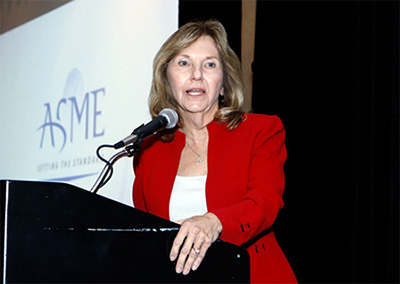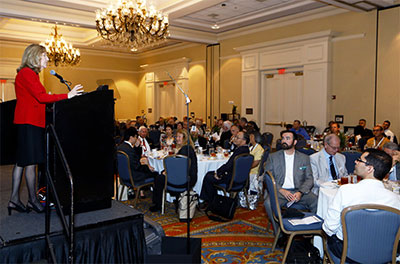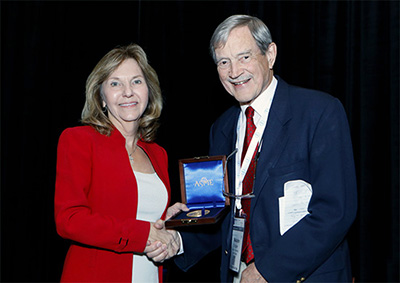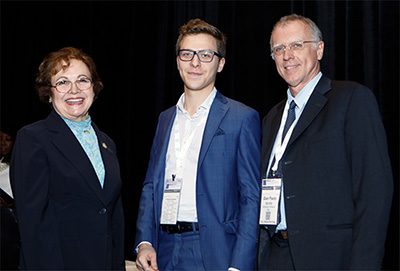ASME President Charla Wise Addresses the Society’s Path at the President’s Luncheon
ASME President Charla Wise Addresses the Society’s Path at the President’s Luncheon
Nov. 20, 2017

During her speech at the President’s Luncheon at the ASME 2017 International Mechanical Engineering Congress and Exposition on Nov. 6 in Tampa, Fla., ASME President Charla Wise discussed the path ASME has embarked upon to become the “go-to” engineering organization for addressing technology-related challenges and the various areas the Society is working on — including leadership, collaboration and engagement — to help assure that it reaches that goal.
On the subject of leadership, Wise recounted the story of an ASME member and former Roe Scholarship recipient, who described her experience as an ASME member as one that made it possible for her to transform from an introverted engineering student into an engineer serving in a leadership role on a major technology company’s advanced technical leadership team. In addition, she still finds time to mentor and teach undergraduate and graduate students, Wise said.

“She is giving back, in service and in heart, to build up for others the professional home that ASME volunteers and members helped her create for herself,” Wise said. “This started with her association with ASME. That is an example of the best of the best. That is who we are.”
Wise used the image of the North Star to illustrate the concept of collaboration. “One of my most important roles I have as president is to help lead all of us, our team … to point us all towards our North Star, moving us forward like an arrow targeted toward its destination,” she said. “The North Star is a symbol I like to use because it’s one of constancy. It’s at the hub of the universe. And so we know where we’re going, what direction we’re headed, regardless of what our starting point is. We’re all headed the same direction.”

As an example of collaboration between Society groups and members making ASME “greater than the sum of its parts,” Wise pointed to the success of this year’s E-Fest Asia Pacific and the inaugural event’s chief coordinator, Prakhar Deep. More than 1,000 students attended the festival, which was organized my more than 250 ASME volunteers. “The staff and the volunteers made a great team,” Wise said. “It was truly collaboration. (Deep) even believes that E-Fest is helping us be more creative in how we define and deliver professional development and peer-to-peer teaming, learning and mentoring.”
Another success story, Wise noted, was a collaboration between ASME Engineering Education and Standards & Certification departments, and volunteers from more than 25 institutions and experts in key standards areas to develop a series of standards-education modules for university curricula. The goal of the program, which is supported by a grant from National Institute of Standards and Technology (NIST), is to reach more than 150,000 mechanical engineering and mechanical engineering technology programs in the United States, as well as students in ABET-accredited programs in 20 additional countries.

In order for ASME to achieve its ambitions of becoming a “go-to” organization, ASME has engaged with not only its own leaders, volunteers and members; it has also sought input from engineers, academics and government professionals outside of the Society to help define what constituted such an organization, Wise said. Among the key discoveries from this effort were that while ASME still draws new members, its recognition by engineers under 35 needs to increase. The Society also needs to improve its perception in the areas of learning and development and original research. In addition, remaining “agile and flexible” must be a primary concern in planning ASME programs and activities.
“Ten years from now, I hope that there is no hesitation when we think of ASME, we think of it as the go-to organization,” Wise said. “But until then, every step we take should bolster our role as a thought leader and an essential resource for innovative technology development. But I have every reason to be encouraged that we are making the right connections and reaching the next generation.”

A number of awards were presented prior to Wise’s speech at the President’s Luncheon, including the Per Bruel Gold Medal for Noise Control and Acoustics, which went to Malcolm Crocker, Ph.D., of Auburn University; the Frank Kreith Energy Award, which was presented to Gershon Grossman, Sc.D., of Technion–Israel Institute of Technology; the Soichiro Honda Medal was given to John E. Dec, Ph.D., of Sandia National Laboratories; the Henry R. Worthington Medal went to Yu-Tai Lee, Ph.D., P.E., who recently retired from the Naval Surface Warfare Center, Carderock Division, West Bethesda, Md.; and the Spirit of St. Louis Medal was awarded to Charbel Farhat, Ph.D., of Stanford University. Also receiving honors at the luncheon were Michael P. Païdoussis, Ph.D., P.E., of McGill University, who was presented the Worcester Reed Warner Medal; Luca Rivadossi, of RVD S.r.l. in Lumezzane, Italy, and Gian Paolo Beretta, Sc.D., of the University of Brescia in Italy, who received the Edward F. Obert Award; and to Qiang Ma and Yihui Zhang, Ph.D., of Tsinghua University, who were awarded the Melville Medal.




